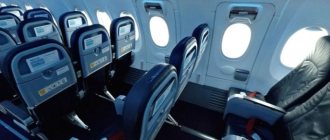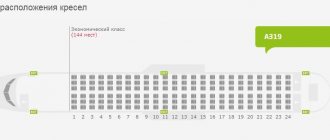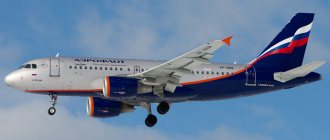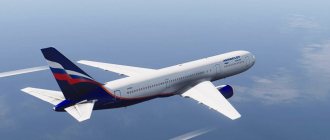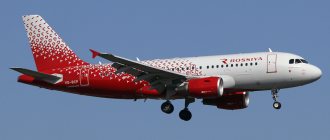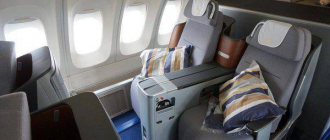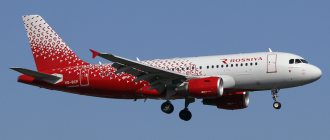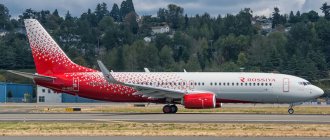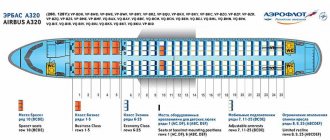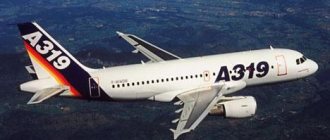Rossiya is the largest airline. The geography of its flights covers 120 routes within the Russian Federation and 22 foreign destinations. In 2014, the Zenit football club appointed Rossiya as its official air carrier.
The main airport is Pulkovo in St. Petersburg. The aircraft fleet includes 61 aircraft, 16 of which are Boeing 737-800.
Boeing 737 airliners are used on short and medium-haul routes.
Aircraft characteristics
Today, the Boeing 737, whose production has not stopped since 1967, is the best-selling aircraft in the entire history of the development of air passenger transport. Boeing is assembled at several factories, the largest of which are located in Everett and Renton. The 737th version of the airliner is produced in the city of Renton (Washington State).
The Boeing 737 is a narrow-body passenger jet that was originally designed for relatively short-range flights with a small number of passengers on board. However, constant market competition has led to the fact that at the moment the Boeing 737 is the name of an entire family of aircraft, including 4 generations of airliners.
- Original. Aircraft of this generation were produced until 1988.
- Classical. Produced until 2000.
- Next Generation (NG). Their production has been established since 1997.
- MAX - aircraft 2016
The most popular aircraft of the third generation is the Boeing 737-800 - an improved version based on the 737-400. Work on its design began in the fall of 1994. Taking into account the wishes of the customer (German aviation), the 737NG version was developed taking into account continuity with the previous generation of Boeings. However, the similarity is preserved only in appearance.
In fact, the aircraft of this generation were thoroughly modernized:
- Thus, the 737-800 model has a larger fuselage, which made it possible to accommodate a larger number of passengers on board.
- The engines were replaced.
- The cockpit is equipped with an EFIS (Full Digital Electronic Flight Information System) released by .
- Added Head-Up Display system.
- The wing area has been increased by 25% and its geometry has been changed. In 2013, designers installed aerodynamic Split Scimitar Winglets on the wings. By reducing vortex resistance, the winglets allowed the airliner to increase lift, reduce fuel consumption by 5.5%, and reduce noise during takeoff.
- 5 years earlier (in 2008), the Safran Messier-Bugatti company, specializing in the production of aircraft landing and braking systems, proposed installing an alternative brake system on Boeings (steel brakes were replaced with carbon ones), which reduced the weight of the aircraft by 250–320 kg, thereby reducing fuel consumption by another 0.5%.
As a result, the aircraft received the following technical characteristics:
| Boeing model 737-800 | |
| Length | 39.5 m |
| Wingspan | 35.7 m |
| Fuselage width | 3.76 m |
| Wing surface | 128.3 sq. m |
| Weight | 41000 kg |
| Maximum take-off weight | 79010 kg |
| Fuel reserve | 26000 l |
| Turbofan aircraft engine (2) | version CFM56-7B24, produced by CFM International |
| Speed | 870 km/h |
| Flight altitude (maximum) | 12500 m |
| Flight range | 5600 km |
Assembly of the first 737-800 model was completed on the last day of June 1997, and a month later it took off for the first time.
A Brief History of the Boeing 737
The Boeing 737 was designed as a narrow-body aircraft to carry a relatively small number of passengers over relatively short distances. Development of the airliner began in 1964. By this time, the company's competitors were conducting flight tests of their models. Boeing lagged behind the BAC-1-11 and DC-9. However, the company's marketers predicted demand in the amount of 600 units of equipment.
And Boeing had to create a new machine. In order to get results faster, the company's engineers decided to borrow a number of technologies from the 707 and 727 models. The fuselage and wing were used for the Boeing 737. But static tests have shown that at 95% of the maximum load, the borrowed elements are damaged and fail.
As a result, Boeing designers had to develop a new wing. A more modern design has improved the dynamic characteristics of the aircraft. The 737 became usable on smaller runways. And the altitude of his flight increased. This allowed for better fuel efficiency.
In 1965, company representatives officially announced the completion of the stage of forming the design of a new airliner. The plane received a more spacious cabin. Instead of the planned 60 seats, the 737 was prepared to accommodate 103 people on board. This was achieved by installing 6 seats in one row of seats.
The Boeing 737, whose passenger capacity had grown under the influence of Lufthansa, entered production on February 22, 1965. The German carrier was the first to sign a contract for the purchase of 22 Boeing 737-100 aircraft. In April 1965, U. Airlines placed an order for 40 737-200 aircraft.
A ceremony dedicated to the completion of the assembly of the first unit of the new airliner was held on January 17, 1967.
The first generation Boeing 737 shared design features with the 727:
- Rudder.
- Kruger brushes.
- Ailerons, the drive of which was carried out using the 2nd hydraulic system.
- Elevator.
- Slat.
From the 707, the new Boeing inherited an electronic system for installing the regulator with redundancy.
Passenger cabin layout
The interior layout of each generation has its own characteristics. This depends on the wishes of the customer, the size of the aircraft, the emergence of new technologies and the desire of the manufacturing company to create the most comfortable conditions for passengers. The 737 NG series salons were created on the basis of the 757 and 767 versions.
The Boeing 737-800 cabin (like other representatives of this generation) is presented in two versions:
- with one class of service;
- with two classes of service.
In the first case, the cabin has all economy class seats (the 800th model is designed for 189 passengers).
The second option assumes the presence of business class and economy class seats in the cabin. The most comfortable seats are in business class, which is always located in the bow of the aircraft and is usually separated from economy class by a plastic partition or curtain.
There are soft, comfortable chairs with an impressive reclining angle. The galley and lavatories for elite clients are also located at the front of the aircraft. In economy class, the seats are less comfortable. Above them are shelves for hand luggage. For the kitchen and toilet rooms, the designers allocated space in the rear of the aircraft.
The most comfortable seats in economy class are those located immediately after the elite cabin. These places are removed from the living quarters and there is fairly wide legroom. Tickets for such seats are sold by many airlines at a higher price or to holders of bonus cards.
The worst seats include those located in the last row. However, statistics call these places the safest in case of a plane crash.
Cost of different Boeing 737 models
The Boeing company does not hide the cost of its aircraft. Data on prices for all aircraft models are posted on the operator’s websites. The most inexpensive model 737-700 will cost the airline 80.6 million USD. The Boeing 737 MAX 9 costs from 116 million USD. Prices for the models reviewed are not final. The cost of an aircraft, just like a car, depends on the passenger capacity and internal equipment.
Customers who are the first to purchase a new airliner can receive a significant discount. Since they take on the responsibility of testing a new flight machine. Therefore, the prices indicated on the websites are not final.
The base costs of Boeing 737 series aircraft are:
| Model. | Amount, million USD. |
| 737 MAX 200 | 115 |
| 737 MAX 8 | 109 |
| 737-900ER | 102 |
| 737-800 | 95 |
| 737 MAX 7 | 90 |
General principles of passenger seating
When placing passengers on board an aircraft, airline employees must provide their customers not only with comfort, but also with safety. The seat number on the boarding pass is indicated during check-in. Each passenger has the right to choose the seat that he considers most convenient for himself. However, there are rules that must be followed.
- Physically healthy and strong people are placed in chairs near emergency hatches. In the event of an emergency evacuation, they will be able to open emergency exits, which requires some effort.
- When the Boeing 737 is not very full, passengers begin to be seated from the middle of the cabin (this is due to the possibility of the aircraft being misaligned).
- People with disabilities are tried not to be placed in places that could create obstacles during forced evacuation.
- It is preferable to place passengers who are afraid of flying further away from the windows.
- It is better for couples to take seats in the middle, while singles and those who constantly need to go to the toilet are more comfortable in chairs located near the aisle.
Military series Boeing 737
There are a number of military and transport aircraft created on the basis of civilian versions of the 737:
- T-43. Used as a training aircraft for training Air Force navigators.
- SLAMMR . Flying scout. Used by the US Navy as a transport vehicle. It is equipped with radar.
- S-40. Passenger plane. It is intended to transport high-ranking military leaders of the US Army.
- Project Wedgetai. Scout plane. It was created on the basis of the 700th. It is intended for long-range location patrol.
- R-8. Multirole aircraft of the US Navy.
The Boeing 737 is widely used in civil and military aviation. Its high passenger capacity makes it an indispensable tool for transporting people over short distances.
Aeroflot
One of the largest airlines in the world is considered to be the Russian Aeroflot, whose origins go back to the distant 30s of the last century. Today, Aeroflot operates 253 airliners, the average age of which is just over 4 years (data as of January 2022). Since 2013, the company has been served by 47 Boeing 737-800.
The transport fleet is constantly updated, so we can talk about high reliability and safety of passenger transportation.
The Boeing 737-800, whose cabin layout includes 2 classes of service, is used on medium-range flights. The board can accommodate 20 business class passengers and 138 economy class passengers.
- Elite seats occupy 5 rows. Each row has 4 seats, arranged in pairs on both sides of the cabin. The width between rows is 1 m. This distance is sufficient for passengers of any height. The most comfortable seats are in rows 2, 3 and 4. Passengers in rows 1 and 5 may be disturbed by the proximity of the kitchen, toilet, or noise from economy class.
- For passengers who have taken an economy ticket, we can recommend row 6 (or the first in the budget part of the cabin). It’s calm here, there’s plenty of legroom, and the back of the row in front doesn’t interfere.
- There are usually no complaints from passengers about rows 7 and 10.
- As for 8 and 9, the window seats can be frustrating. If on 9 the location of the porthole is shifted to the row in front, then on 8 they are completely absent.
- Rows 11 and 12 will not suit those passengers who planned to spend time in a reclining seat during the flight. The backs of the seats in these rows are fixed, as there are emergency hatches behind them. The only thing that can please passengers in the 12th row is increased legroom.
- The 13th row (contrary to superstitions) is very comfortable: the chair reclines well, a great distance from the 12th row. However, due to safety precautions, passengers with disabilities, the elderly, with children, animals, and pregnant women are not accommodated here.
- The seats in the 28th row may be uncomfortable: the proximity of the kitchen, toilet, and the back of the chair does not always recline sufficiently.
| Comfort level | Rows (seats) |
| The best |
|
| Regular |
|
| Uncomfortable |
|
Orders
By May 2014, the new aircraft had received more than 2,200 orders from 47 different buyers, 100 of which were issued by American Airlines, 201 by Indonesian Lion Air, 35 by American Aviation Capital Group and Southwest Airlines with an order for 200 aircraft. Norwegian Air Shuttle became the first European customer for the new 737, with an order of 100 units.
The Boeing 737 MAX is the best-selling aircraft in the company's history: the number of orders for such aircraft has already exceeded 2,000 units worldwide (early 2019). According to the manufacturer, buyers of the new generation Boeing 737 aircraft include the world's largest airlines, including Russian ones.
| order date | Customer | B737 MAX 7 | B737 MAX 8 | B737 MAX 9 | B737 MAX 10 | Total | Source |
| December 13, 2011 | Southwest Airlines | 30 | 170 | 200 | |||
| January 24, 2012 | Norwegian Air Shuttle | 100 | 100 | ||||
| February 22, 2012 | Lion Air | 1 | 200 | 201 | |||
| July 6, 2012 | Virgin Australia | 23 | 23 | ||||
| July 3, 2012 | Air Lease (ALC) | 89 | 15 | 104 | |||
| July 12, 2012 | United Airlines | 100 | 100 | ||||
| September 20, 2012 | Avolon | 10 | 10 | 20 | |||
| October 1, 2012 | Gol Transportes Aéreos | 60 | 60 | ||||
| October 3, 2012 | GECAS | 95 | 95 | ||||
| October 11, 2012 | Alaska Airlines | 20 | 17 | 37 | |||
| November 4, 2012 | ALAFCO | 20 | 20 | ||||
| November 5, 2012 | Aeromexico | 60 | 60 | ||||
| November 14, 2012 | SilkAir | 31 | 31 | ||||
| January 2, 2013 | Aviation Capital Group | 50 | 10 | 60 | |||
| February 13, 2013 | American Airlines | 100 | 100 | ||||
| May 14, 2013 | Icelandair | 9 | 7 | 16 | |||
| May 15, 2013 | Turkish Airlines | 55 | 10 | 65 | |||
| June 19, 2013 | CIT Group | 30 | 30 | ||||
| July 10, 2013 | TUI Travel | 40 | 20 | 60 | |||
| August 7, 2013 | Travel Service Airlines | 3 | 3 | ||||
| September 26, 2013 | WestJet | 25 | 40 | 65 | |||
| January 6, 2014 | Flydubai | 75 | 75 | ||||
| February 19, 2014 | SunExpress | 15 | 15 | ||||
| March 12, 2014 | SpiceJet | 42 | 42 | ||||
| March 19, 2014 | Comair | 8 | 8 | ||||
| April 1, 2014 | Air Canada | 33 | 28 | 61 | |||
| April 2, 2014 | Private customer | 1 | 1 | ||||
| May 21, 2014 | Nok Air | 8 | 8 | ||||
| July 14, 2014 | Okay Airways | 6 | 6 | ||||
| August 25, 2014 | BOC Aviation | 50 | 50 | ||||
| September 20, 2014 | Ethiopian Airlines | 20 | 20 | ||||
| October 12, 2014 | Garuda Indonesia | 1 | 1 | ||||
| October 31, 2014 | Monarch Airlines | 30 | 30 | ||||
| November 10, 2014 | SMBC Aviation Capital | 80 | 80 | ||||
| December 1, 2014 | Ryanair | 100 | 100 | ||||
| December 15, 2014 | Jetliners | 5 | 5 | ||||
| S7 Airlines | 9 | 9 | |||||
| January 17, 2018 | SCAT Airlines | 6 | 2 | 8 | |||
| March 20, 2018 | SkyUp Airlines | 2 | 3 | 5 | |||
| May 10, 2018 | NordStar | 30 | 30 | ||||
| May 25, 2018 | Ural Airlines | 14 | 14 | ||||
| July 17, 2018 | Belavia | 4 | 4 | ||||
| September 14, 2018 | Ukraine International Airlines | 3 | 3 | ||||
| NordStar | |||||||
| Air China | 8 | 8 |
"S7 Airlines" (brand name of the airline)
This Russian carrier owns the largest network of domestic routes based at the air transport hubs of Moscow, Novosibirsk, and Irkutsk. Provides both domestic and international passenger transportation. In total, the company operates 92 aircraft, including 21 Boeing 737-800, which have 2 slightly different layouts.
The Boeing 737-800 (the cabin layout of one variant differs from the other only in that one of the rows has not 6, but 4 seats) is equipped with two classes of service. There are 8 seats allocated for business class, and 168 for economy class (a total of 176 seats).
- In one of the layouts, the business class compartment includes 8 seats arranged in 2 rows.
- Economy class starts from row 3, which can also be considered the most comfortable.
- 4–11 and 15–29 have a good level of comfort. The only thing that should be clarified during registration is the presence of portholes in row 9 (they may not be there).
- Rows 12 and 13 cannot be called comfortable due to their location in the emergency exit area. Therefore, the backs of the seats in rows 12 and 13 do not recline to the desired position.
- 14 – very comfortable row: reclining backrests, enough legroom.
- The last 30th row is not very convenient due to its close proximity to the wall, kitchen and toilet areas.
Aircraft reputation
During its operation, passengers fell in love with the liner due to its “heavenly” soothing interior, large capacity and comfort. The aircraft's excellent performance and ergonomics have made the model one of the most popular among airlines.
Reliability assessment
The manufacturer evaluates the model according to high reliability indicators - up to 99.8%. However, due to the decision of the US authorities to ban the operation of the entire Boeing 737 MAX family, the manufacturer also decided to suspend production.
Maneuvering Characteristics Augmentation System (MCAS) - helps pilots determine the aircraft's position in the air. It was in this system that failures were discovered. The introduction of the MCAS system was necessary because the aircraft's engines were enlarged, causing it to raise its nose upward. MCAS regulates the aircraft's deflection in the air and points the nose down. However, like any automated system, it can fail, which affects the reputation of the airliner.
Accidents and disasters
The Boeing 737 MAX 8 is notorious for two major crashes due to similar circumstances:
- October 29, 2022 - An Indonesian Lion Air flight crashed after 13 minutes from Jakarta. 189 people died.
- March 10, 2022 - the plane crashed six minutes after taking off from the capital of Ethiopia, Addis Ababa. All 157 people died.
Last news
On March 10, 2022, a serious plane crash involving a Boeing 737 MAX 8 occurred in Ethiopia. After this, Chinese airlines decided to suspend operation of this model. The Civil Aviation Administration of China noticed similarities between the Lion Air crashes in Ethiopia and Indonesia in October 2022.
On March 12, 2022, Germany, France, Austria and the UK abandoned the use of the Boeing 737 MAX 8. Following them, the rest of the European Union countries closed the airspace for this model.
Until the precise cause of the plane crash in Ethiopia is clarified, Vietnam, Indonesia, Mongolia, Oman, the Russian Federation, Kazakhstan and Singapore refused to carry the Boeing 737 MAX 8.
On March 13, 2022, Donald Trump announced a ban on the operation of all modifications of the Boeing 737 MAX. The total number of countries that have abandoned the use of the Boeing 737 MAX 8 exceeds 40.
The US Federal Aviation Administration studied satellite information and concluded that the crash that occurred in October 2022 in Indonesia has a similar scenario to the Ethiopian Airlines flight. According to official data from the black box on board Lion Air, before the fall, the sensors on the control panel gave false information, which caused the plane to tilt. However, after the incident in Indonesia, Boeing sent instructions to correct problems with the sensors.
Boeing shares sank in price due to these events. Due to the US President's ban on the operation of the Boeing 737MAX, Boeing has suspended deliveries of this model.
"Victory"
Budget Aviation (a subsidiary of Aeroflot) was founded in September 2014. In 2022, the daily flight hours of Pobeda airliners were higher than those of other global air carriers.
The company's passenger transportation is carried out only by Boeing. At the end of 2022, there were 23 aircraft in the fleet and 7 more Boeing 800 models were ordered.
The aircraft serving the company have an economy class configuration.
The Boeing 737-800 (standard cabin layout) can carry 189 passengers. The cabin has 32 rows. There are 3 chairs on each side of the cabin.
In the 1st row there are only 3 seats on the left side. You can choose your own seats, but for a fee.
The distance between the rows is small, the backs of the seats are static. However, here you can find more comfortable places.
- The most expensive and comfortable seats (with increased legroom) are those located in the 1st row (A, B, C), 2nd (D, E, F), as well as seats in the 15th and 16th rows.
- Seats in rows 3–14 and row 2 (seats A, B, C) are cheaper. But in the area of the 12th row there are no portholes. The listed seats are suitable for passengers who are in a hurry to get to the gate at the end of the flight.
- For those who are not in a hurry and save money, you can buy tickets for seats in the rear section, located from row 17 to row 30 inclusive.
- Seats in rows 31 and 32 are not cheaply priced by the company, although there are no visible amenities here.
Place of production, operating companies
The Boeing 737, whose passenger capacity has changed with the introduction of the new model, is undergoing final assembly at the Boeing Commercial Airplanes plant in Renton. It is a small city in the USA in the state of Washington. The settlement is located 21 km from Seattle. The settlement was created in 1860.
The basis for the future city was a local mine and a woodworking enterprise. But until September 2, 1939, Renton remained a village. With the outbreak of World War II, a B-29 production plant was built in the city. At the end of hostilities, it was planned to build an enterprise producing amphibious aircraft in the locality. But the idea was abandoned.
It was not until 1970 that Boeing began production of the city's most popular short-range and high-capacity aircraft. So in 2000, the population of Renton was 50 thousand people, and in 2010 - 90 thousand people. The prosperity of the Boeing company has a fruitful effect on the development of the locality.
Aircraft manufactured in Renton are operated in more than 20 countries around the world. The fleet of 12 Russian airlines includes Boeing Classic series aircraft.
This includes:
- 737-300.
- 737-400.
- 737-500.
These carriers include: Yakutia, UT Air, Orenburg Airlines, Tatarstan, Yamal.
"Russia"
The airline began operating flights in 2006. In 2022, it took second place in terms of the number of passengers carried. There are 17 Boeings in the aircraft fleet. Airplanes of two configurations: with and without business class.
The interior layouts of airliners with different side numbers have differences in the numbering of seats:
- A, B, E, F for a liner with registration number VP-BUS;
- A, C, D, F for VQ-BUV, VQ-BVV.
In Rossiya Boeings, business class is designed for 12 people: 3 rows of 4 comfortable wide seats (a pair on each side of the cabin). Fastenings for cradles are installed in front of the first row. Particularly picky passengers will be more comfortable in the 2nd row.
Salons of different service levels are separated by a solid partition. Economy class starts at 4 and ends at 29. The layout of passenger cabins for aircraft with different tail numbers is slightly different.
- The 4th row seats are considered the best. The distribution of in-flight meals begins from there, the backrests of the row in front, close to the exit, do not interfere. In addition, VQ-BUV, VQ-BVV have a mount for bassinets on the partition separating business class (this is very important for passengers with small children).
- Seats with fixed backs are not very comfortable. These are rows 12, 13, 29 for Boeings with onboard designations VQ-BUV and VQ-BVV. And the VP-BUS liner has rows 11, 12, 29.
- The most comfortable seats in economy class (called “SPACE+”) are located in row 13 (VP-BUS) and 14 (VQ-BUV and VQ-BVV).
- The most uncomfortable (due to proximity to the toilet) are rows 28 and 29.
Boeing 737-800s, equipped with only one class of service, also have a slight difference in the cabin layout. An aircraft with the number VQ-BUE has 3 seats in the first row - D, E, F. For other airliners, the seats in the first row are designated A, B, C. The aircraft cabin is designed for 32 rows. Each row (except 1) has 6 seats: 3 on each side of the board.
- The absence of business class allows us to classify the seats in the first 4 rows (in the cabin diagram they are designated as “front rows”) as the most comfortable. They are sold at an additional cost.
- For passengers with small children, it is better to choose rows 1 and 2. In front of them there are mounts for cradles.
- Not very comfortable seats in rows 14, 15, 32 (the backs of the seats are fixed).
- Passengers in row 16 will feel comfortable. There is plenty of legroom here.
- It won’t be news that passengers don’t like the last two rows.
737 Classic generation
Due to the technical and moral obsolescence of the Original series aircraft, the Boeing company in 1979 began design studies to create a new generation of 737. The work was carried out on the basis of the creation of the 200th model. And in 1980, the new aircraft received the index 737-300.
This model has common systems with the previous generation:
- Air ventilation and cooling.
- Glider.
- Control and monitoring of parameters during flight.
But at the heart of the 300 is a new aircraft, equipped with electronic avionics, modern powertrains and a new cabin.
737-300
The Boeing 737-300 is the first representative of a new family of aircraft from the American manufacturer. The airliner's fuselage is longer than its predecessors (33.18 m). This is almost 2.5 m higher than that of the 200th. The changes also affected the parameters of the wing. Its length increased to 28.88 m.
The Classic generation is characterized by a change in the type of construction materials used. At 300, a large share is occupied by composite compounds. New CFM engines were also installed on the aircraft.
The Boeing 737-300, whose passenger capacity reaches 150 people, has common features of the cabin organization with the first aircraft in the series. However, the airliner's interior is completely devoid of luxury seats. From rows 1 to 24, all aircraft boarding lines consist of 6 seats, 3 on the left and on the right. The most comfortable places are considered to be 1D-F, 2A-F, 9B-E, 10A and 10F.
737-400
The Boeing 737-400 model appeared as an attempt by the company to take advantage of the sales success of the first aircraft of the Classic family. The 400's hull length has increased slightly and its maximum payload has increased. Due to this, the flight range was reduced, but it was possible to increase the cabin capacity by 3 rows of seats.
There are 2 interior layouts for aircraft of this series:
- With business class seats from rows 2 to 4. The seats are arranged 4 in a row (2 on each side).
- With luxury seats from 2 to 4 boarding lines. Economy Plus means the presence of 6 seats in one boarding line.
737-500
The Boeing 737-500 is a shorter version of the 200. Engineers managed to increase the permissible flight range by reducing capacity. This aircraft is the youngest in the Classic family. Boeing Airplanes produced these airliners from 1990 to 1999. The aircraft cabin is divided into an increased comfort zone (landing lines 1 to 2) and standard seats.
In first class, the seats are arranged 4 in a row. Seats 1A-1D are considered preferable. In economy, seats in rows 3, 12 and 14 allow you to sit with the greatest comfort. The seats in line 10 are located in front of the emergency exits. The backs of the seats do not fall down. Row 24 is adjacent to the aircraft sanitary area.
Dimensions and flight characteristics:
| Name | 737-300 | 737-400 | 737-500 |
| Wingspan, m | 28,88 | ||
| Empty weight, t | 32,46 | 34,27 | 31,51 |
| Maximum weight, t | 62,8 | 68,1 | 60,55 |
| Developed force, kgf | 2*9970 | 2*10670 | 2*9080 |
| Power unit | CFM56-3C1 | ||
| Maximum speed, km/h | 945 | ||
| Cruising speed, km/h | 910 | ||
| Practical range, km | 4670 | 5000 | 5550 |
| Service ceiling, km | 10,2 | 11,3 | 11,3 |
| Aircraft length, m | 33,40 | 36,40 | 31 |
| Aircraft height, m | 11,13 | ||
"Nordwind" (Nordwind, North Wind)
Nordwind (North Wind) is a Russian carrier that began operating in 2008. The company is now one of the ten largest in terms of passenger turnover. Northern Wind flights are provided by 7 Boeings of the same class of service. The park is being updated. At the end of July and beginning of August 2022, the carrier received 2 more Boeing 737-800 NG of the latest assembly.
The Boeing 737-800 (standard cabin layout) accommodates 189 passengers on board.
Based on the airline’s recommendations, seats can be distributed according to comfort as follows:
| Comfort level | Rows (seats) |
| Comfortable |
|
| Preferred |
|
| Regular (uncategorized) |
|
| Worst |
|
An additional convenience in newly received aircraft is that the windows on the emergency hatches close from bottom to top.
Azur Air
Azur Air is a very young Russian airline that began operating independently in 2015. Before that, it was a division of the airline. The company's air travel is provided by Boeings with one class of service.
The cabin has 32 rows with a standard seating arrangement:
- The most comfortable are seats D, E, F in the second row. In addition, there is space for strollers.
AZUR air Boeing 737 800. Interior diagram - The seats in the first row are good, but being close to the toilet can create discomfort.
- There is plenty of legroom in front of row 15, but the seatbacks do not recline.
- Row 16 is the most comfortable.
- Uncomfortable seats are located in row 14 (not folding chairs, standard leg distance), and seats in row 32 are also located in close proximity to the toilet.
"NordStar" (NordStar)
NordStar is one of the 15 largest Russian air carriers. Its fleet includes 9 Boeing 737 800 models. The salons are presented in two layouts. Up to 180 passengers can be accommodated on board.
Layout 1
Business class has 6 seats, economy class has 174 seats.
- On all planes, the most comfortable seats are in business class. In Boeings servicing NordStar, these are rows 1 and 2.
- The 3rd row, which begins the economy section, also belongs to very comfortable seats (close to the exit, large distance for the legs). The distribution of food begins from the bow.
- The most comfortable seats are located in row 15 (“SPACE+”, folding chairs).
- 13 and 14 (“SPACE+”, but the seat backs are fixed).
- The seats in the 31st row are considered the worst (the backs of the seats rest against the wall and the proximity of the toilet).
Layout 2
There are 10 seats in business class, 162 in economy class.
- Rows 1–3 in business class and row 5 in economy class are considered the most comfortable.
- Rows 14 and 15 have plenty of legroom, but the backrests are locked.
Which airlines operate
The Boeing 737 MAX 8 is one of the best-selling airliner models.
The Boeing 737 MAX is actively operated by the following companies:
- Southwest Airlines (USA) - 170.
- American Airlines (USA) - 100.
- Alaska Airlines (USA) - 20.
- Air Canada (Canada) - 33.
- WestJet (Canada) - 40.
- Aeromexico (Mexico) - 60.
- Gol Transportes Aéreos (Brazil) - 60.
- Virgin Australia (Australia) - 23.
- Monarch Airlines (UK) - 50.
- Ryanair (Ireland) - 100.
- Norwegian Air International (Norway) - 100.
- Icelandair (Iceland) - 9.
- TUI Travel (Germany) - 40.
- Travel Service Airlines (Czech Republic) - 3.
- Turkish Airlines (Türkiye) - 55.
- SunExpress (Türkiye) - 15.
- SkyUp Airlines (Ukraine) - 2.
- Ukraine International Airlines (Ukraine) - 3.
- Belavia (Belarus) - 4.
- S7 Airlines (Russia) - 9.
- Utair (Russia) - 30.
- Ural Airlines (Russia) - 14.
- SCAT airlines (Kazakhstan) - 6.
- Flydubai (UAE) - 75.
- SpiceJet (India) - 42.
- Lion Air (Indonesia) - 1.
- Garuda Indonesia (Indonesia) - 50.
- SilkAir (Singapore) - 31.
- Nok Air (Thailand) - 8.
- Air China (China) - 8.
- Okay Airways (China) - 6.
- Ethiopian Airlines (Ethiopia) - 20.
- Comair (South Africa) - 8.
UTair
Air is one of the largest in Russia. As of October 2022, the carrier’s fleet included 9 Boeing 737-800. They are presented in two configurations: with and without business class. The cabin of the aircraft, equipped with two classes of service, accommodates 159 passengers.
- With this arrangement, rows 1–3 of business class are the most convenient.
- Rows 4–9 are already in economy class, but this part of the cabin is still in the comfort zone (that is, economy comfort): comfortable seats, sufficient distance between the rows, a larger selection of dishes. The best seats are in the 4th row.
- From rows 10 to 28 – economy zone. The best seats here are in row 12. The worst are at 27 and 28.
The single-class cabin accommodates 186 seats. Rows 1, 14 and 15 in the diagram are marked as the most convenient.
"Yakutia"
Yakutia is a Russian airline whose fleet at the beginning of 2022 included 5 Boeing 737-800. The aircraft have two configurations: 170 and 172 seats. The difference lies in the two additional seats that complement business class.
The layout for 170 seats includes 10 seats in business class (3 rows of 2 seats on the left side of the board and 2 rows on the right). "Economy" has a capacity of 162 seats.
- The most successful choice would be seats in rows 2 and 3, since seats A and C in the first row are close to the restrooms.
- The best budget seats are in row 5: spacious, you can choose the right food. All front rows (up to 12) are also a good choice: less engine noise, close to the exit, good menu.
- In rows 12–18, there is less turbulence, but the view from the windows is partially blocked by the wings of the aircraft. When choosing a comfortable seat, it is better to stay in row 15. The only inconvenience is that the table is built into the arm of the chair. The 13th and 14th rows are located in the emergency exit area, which does not allow the backrest to be reclined. If the flight is short, then the seats in these rows are quite comfortable.
- Seats from rows 19 to 31 belong to the lowest level of comfort (at least due to increased engine noise).
Accidents and disasters
During the operation of the Boeing 737 MAX since May 2022, 4 airliners have been lost.
| date | Board number | Scene of the incident | Victims/On Board | Short description |
| 29.10.2018 | PK-LQP | Jakarta | 189/189 | Fell into the sea shortly after takeoff due to erroneous actions of the crew as a result of unreliable readings from the MCAS system. The investigation is ongoing. |
| 14.12.2018 | LN-BKE | Shiraz | 0/180 | Forced landing due to failure of one of the engines. The plane could not take off from Iran for two months due to US sanctions. |
| 10.03.2019 | ET-AVJ | Addis Ababa | 157/157 | Crashed shortly after takeoff. The investigation is ongoing. |
| 26.03.2019 | SWA-8701 | Orlando | 0/2 | Ferry flight. Forced landing due to engine problems. |
"FlyDubai"
State-owned airline serving at budget rates. It began its work in 2008. If you believe the 2018 rating, Flydubai is in 77th position in the list of the top hundred safest air carriers. Since the summer of 2013, passengers have been served by Boeings of 2 configuration types. At the beginning of 2022, the company’s fleet includes 12 aircraft with one class of service and 43 with two.
The economy cabin has 32 rows.
- Row 16 is considered the best.
- The seats in the 15th row are good, but they have a drawback: seats that do not lie down.
- For many, the convenience of seats A, B, C of the first row seems dubious (proximity to the toilet; a table built into the armrest reduces the area of the seat). Therefore, it is better to take a ticket for seats D, E, F of the second row.
- The most undesirable seats are those located in the 14th and 32nd rows (small legroom, non-folding seats, and there is also a toilet behind the 32nd row).
Boeings with a VIP area have 12 business class seats arranged in 3 rows. Here, the most comfortable seats will be business class and the first rows of economy class. If tickets for these seats have already been sold, then you can stay in rows 15 or 16 (next to the emergency hatches).
"Alrosa"
Alrosa is a Russian regional carrier that has been operating as an independent legal entity since the beginning of 2013. The airline operates airplanes and helicopters from the period of Soviet aircraft construction. But the air fleet is being updated.
At the moment, air routes are served by 3 Boeing 737-800. The aircraft's cabins are designed for 156 passengers: 12 business class seats, 144 economy class seats.
With this configuration, the distances between the rows are sufficient, so the seats are quite comfortable. When choosing the most convenient ones, you should pay attention to business class seats, the initial row of economy class and rows 11 and 12 at the emergency exits.
In the interior diagram, the last row (27th) stands somewhat apart, which suggests folding seats and increased legroom.
Boeing 737 series
In 2022, airlines in many countries operate Boeing 737 aircraft of all series. The exceptions are 737-100 and 737-200. Both of these models are characterized by increased noise.
Despite the installation of protective screens, the manufacturer was unable to cope with this problem. These airliners are also expensive to maintain. The 200 series aircraft are used by some African carriers.
Recommendations for choosing seats
To ensure that your flight experience remains as positive as possible, a balanced choice of passenger seat should be given top priority. Boeing 737-800s serve many airlines. However, each carrier expresses its own requirements and wishes when purchasing an aircraft. Therefore, aircraft of the same modification have a number of nuances in the layout of the passenger cabin.
To find a comfortable place for yourself, you should use some tips:
- Find out the registration number of the aircraft and study in detail the layout of its interior.
- Pay attention to such points as the distance between the rows and whether the back of the chair is locked.
- Check the presence of a porthole (there are rows without it), and the viewing width.
- For those who do not tolerate shaking well, it is better to look for a suitable place in the bow of the aircraft.
- Don’t forget about the advantages that the last rows have: usually there are no passengers with children here and this is the safest place in the event of an accident (up to 70% of survivors of a plane crash sat in the back rows of the plane).
And one more secret. It is important to make a good impression on the check-in staff, and they will indicate on the cabin map the best seats on board the Boeing 737-800 that serves their airline.
Author: Irina Zhuravka
Article design: Vladimir the Great

